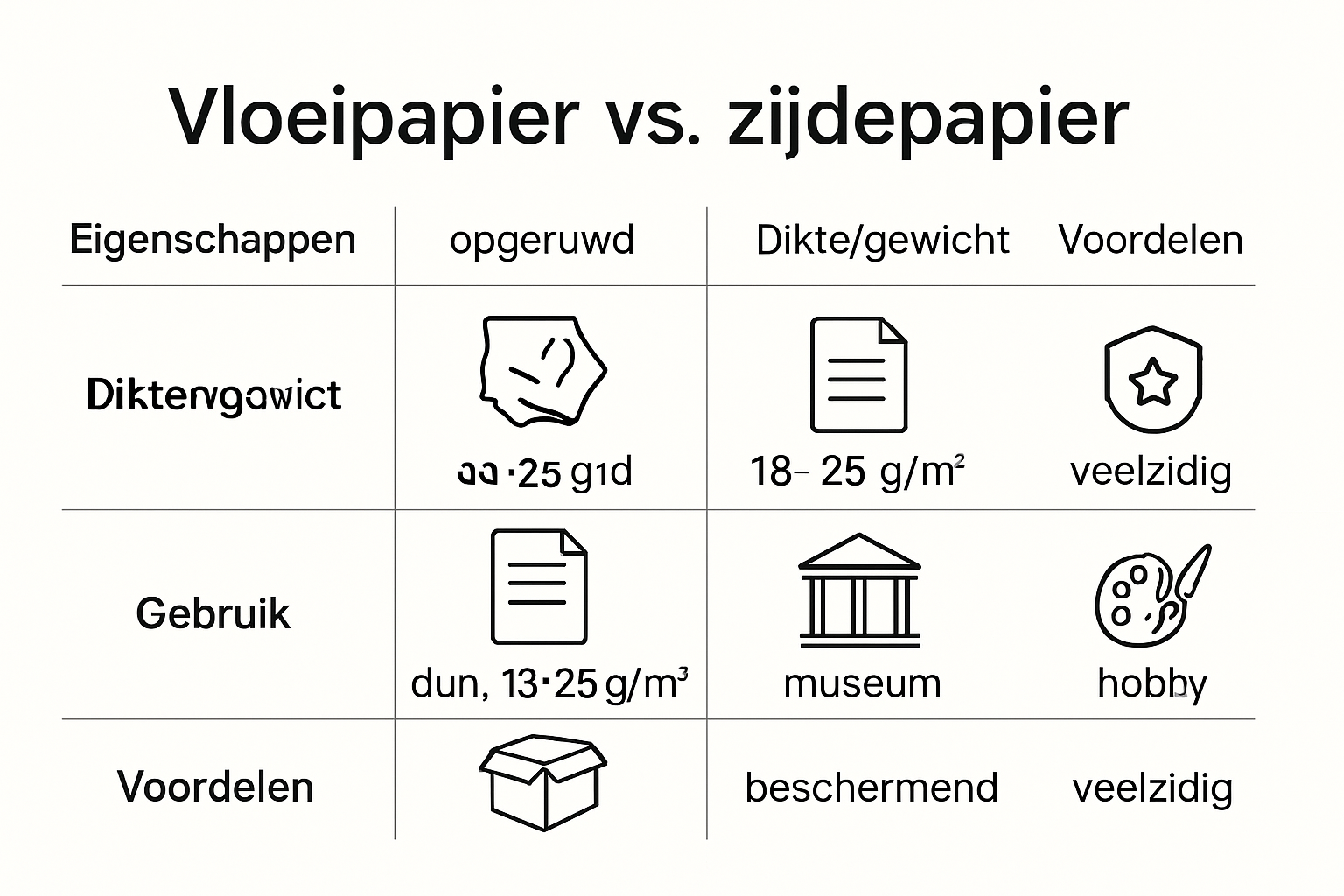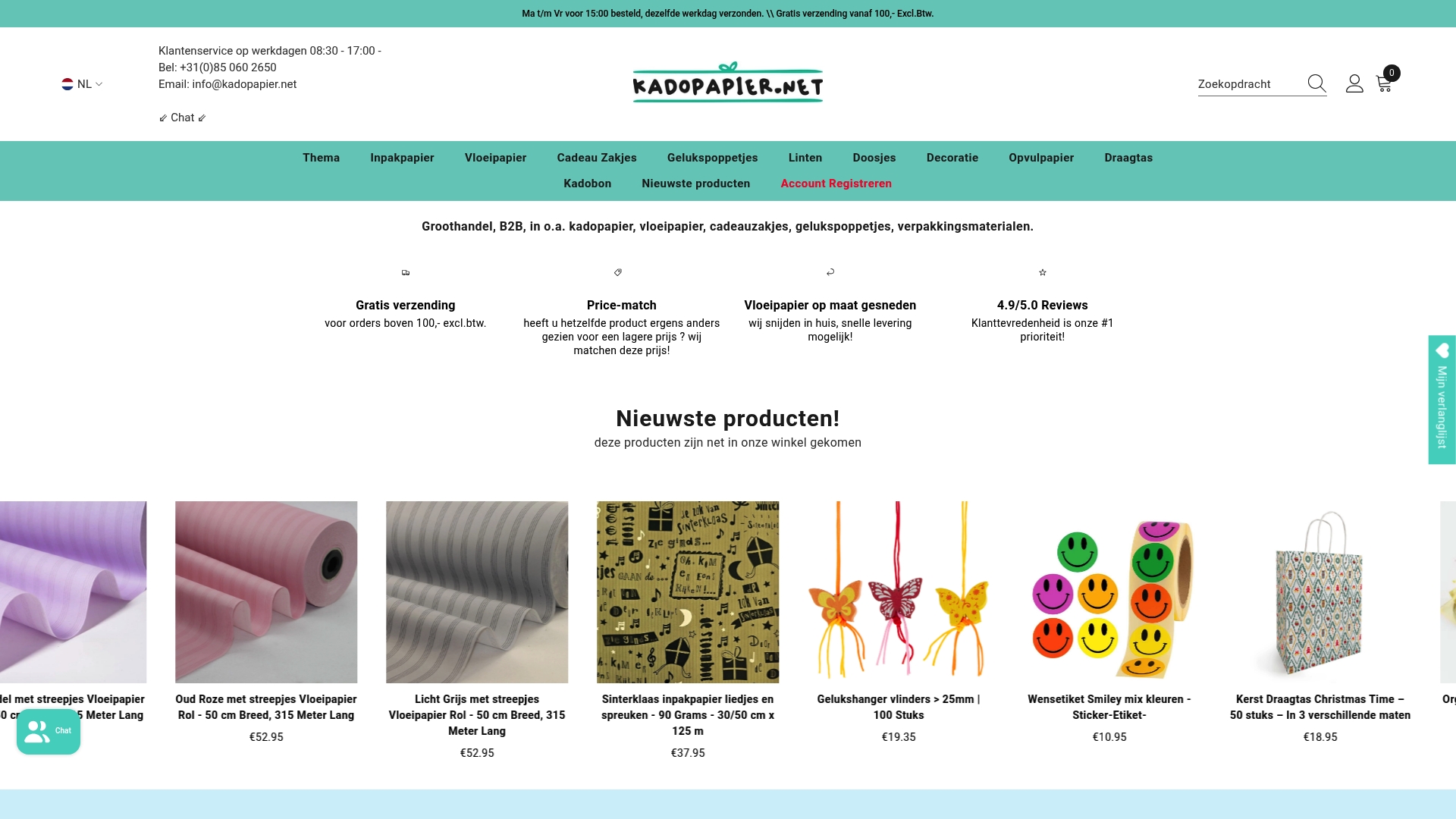Difference between tissue paper and tissue paper: applications 2025

Tissue paper and tissue paper look similar, yet they differ significantly in what they do for shops, crafters, and museums. Everyone understands that paper is important, but did you know that tissue paper often weighs less than 25 grams per square meter , offering unique protection for fragile items? You might think that tissue paper is primarily for craft projects, but it's actually indispensable for conservation and is even used to protect valuable artwork from moisture and dirt. This makes you wonder which paper you really need.
Table of contents
- What is tissue paper and what is tissue paper?
- Main differences in material and use
- Applications for shops, hobbies and industry
- Tips for choosing the right paper
Quick Summary
| Takeaway | Explanation |
|---|---|
| Tissue paper effectively absorbs surfaces | Suitable for absorbing liquids and protecting delicate objects. Its porous structure provides high absorbency. |
| Tissue paper provides protection during transport | Ideal for packaging fragile items like glassware. Its thin yet strong structure absorbs shocks and prevents damage. |
| Choose acid-free paper for conservation | To protect historical documents and works of art, acid-free tissue paper is essential to prevent acid damage. |
| Consider paper thickness and weight when applying | The thickness and weight of the paper affect its suitability for different projects, such as industrial or creative purposes. |
| Sustainability in paper production is becoming increasingly important | Manufacturers are focusing on environmentally friendly and recycled options, which is crucial for the future of packaging materials. |
What is tissue paper and what is tissue paper?
In the world of packaging materials, tissue paper and tissue paper play a crucial role, but many people often confuse these two types of paper. While both have a delicate and thin appearance, they have different properties and applications.
Tissue Paper: The Versatile Absorbent Friend
Tissue paper is a special type of paper with unique characteristics. According to heritage research, blotting paper is produced without sizing, with the primary purpose of absorbing water or ink. It is typically made from cotton linters or chemical pulp with minimal water-soluble impurities.
The properties of tissue paper are remarkable. It is typically thick, voluminous, and extremely porous. Some varieties are even reinforced with a wet strength enhancer to facilitate use in humid conditions. Its absorbency makes it popular for various applications, such as protecting delicate items, absorbing excess liquids, or as decorative wrapping material.
Tissue Paper: The Protective Packaging Specialist
Cultural heritage research describes tissue paper as an extremely thin type of paper, weighing less than 25 g/m². It is primarily used for protection and shock absorption. Acid-free tissue paper is particularly popular in the conservation world.
Tissue paper can have two different physical properties. Some types have a soft, absorbent consistency that effectively absorbs moisture. Other varieties are hard and smooth, making them ideal for wrapping and protecting fragile items. This diversity makes tissue paper an indispensable material in packaging and preservation processes.
The difference between tissue paper and tissue paper lies not only in their composition, but also in their specific functions. While tissue paper focuses on absorption and volume, tissue paper specializes in protection and delicate packaging. Both materials are indispensable in various industries, from gift wrapping to art conservation.
Regardless of their specific application, tissue paper and tissue paper share one common characteristic: they are lightweight, flexible, and highly functional. Whether you want to protect a delicate artwork, elegantly wrap a gift, or absorb excess liquid, these papers are ready to serve you.

Main differences in material and use
When comparing tissue paper and tissue paper, there are essential nuances in material, composition, and applications that fundamentally differentiate these types of paper. The choice between these two materials depends on the specific application and desired properties.
Material Properties and Composition
Tissue paper and tissue paper differ significantly in their physical properties. Cultural heritage research shows that tissue paper is characterized by a porous, voluminous structure. It is produced without sizing, giving it high absorbency. Tissue paper, on the other hand, is extremely thin, weighing less than 25 g/m², and has a more layered and structured composition.
The production techniques also differ. Tissue paper is typically made from cotton linters or chemical pulp with minimal water-soluble impurities. Tissue paper is produced using specific techniques that result in a smooth or absorbent surface, depending on the intended application. Heritage research emphasizes that acid-free tissue paper is particularly popular in conservation processes.
Below you will find a comparison table that summarizes the key differences in material properties and composition of tissue paper and tissue paper:
| Feature | Tissue paper | Tissue paper |
|---|---|---|
| Structure | Porous, voluminous | Thin, layered or smooth |
| Weight per m² | Higher than 25 g/m² (usually thicker) | Less than 25 g/m² (very thin) |
| Production technology | No gluing, cotton linters/chemical pulp | Specific techniques for smoothness/absorption |
| Absorption capacity | Very high | Variable: soft (absorbent), hard (not) |
| Primary use | Absorption, buffering, protection | Protection, shock absorption, packaging |
| Specially available acid-free | Yes | Yes (essential for conservation) |
Specific Uses
The difference in material composition determines its various uses. Tissue paper is ideal for absorbent tasks such as catching excess liquids, protecting delicate surfaces, or as decorative wrapping material. Its porosity makes it ideal for situations where moisture absorption or buffering is required.
Tissue paper, on the other hand, is primarily used for protective purposes. It's excellent for wrapping fragile items, absorbing shocks, and creating a protective layer. Its thin yet strong structure makes it perfect for gift wrapping and preservation techniques .
The choice between tissue paper and tissue paper depends on the specific requirements of your project. While tissue paper focuses on absorption and volume, tissue paper focuses on protection and delicate packaging. Both materials are indispensable in various industries, from art conservation to gift wrapping.
In practice, these types of paper often complement each other. An artist might use tissue paper to protect a delicate artwork, while blotting paper is used to absorb excess restoration fluids. A gift can be wrapped in tissue paper for a luxurious finish, with blotting paper as an additional protective layer.
Regardless of the specific application, both types of paper remain indispensable in numerous professional and creative contexts. Their unique properties make them more than just paper: they are tools for protection, presentation, and precision.
Applications for shops, hobbies and industry
Tissue paper and tissue paper are indispensable materials in numerous sectors, from retail to industrial applications. Their versatility makes them essential for professionals and hobbyists alike.
The following overview shows the main applications of tissue paper and tissue paper by sector, based on their specific properties as mentioned in the article:
| Sector | Tissue Paper Application | Tissue Paper Application |
|---|---|---|
| Retail/sales | Filling in goodie bags, gift bags, protection | Packaging of fragile products, luxury packaging |
| Hobby/creative | Crafts, origami, decorative projects | Flower arrangements, delicate decoration, protective layer |
| Industrial/professional | Conservation, restoration, museum archiving | Protection during transport, shock absorption |
Retail and Sales
Packaging specialists emphasize that tissue paper plays a crucial role in retail. It's particularly well-suited for packaging delicate items like jewelry and glassware. A unique feature is that it doesn't stain, even when it comes into contact with water, making it ideal for stylishly wrapping clothing and accessories.
Tissue paper is also popular in retail. Industry research shows it's widely used in clothing stores, shoe stores, jewelry stores, and perfumeries. It serves as filler in goodie bags, gift bags, and boxes, and is essential for wrapping fragile gifts.
Hobby and Creative Applications
These types of paper are incredibly popular among hobbyists and in educational settings. Tissue paper is often used in craft projects in elementary schools, for making decorative objects, folding origami, or creating colorful embellishments. Our guide to creative packaging offers inspiration for countless DIY projects.
Tissue paper lends itself perfectly to more refined creative applications. It's used for creating delicate decorations, floral arrangements, and as a protective layer in art projects. Its transparency and soft texture make it perfect for layered artwork.
Industrial and Professional Applications
In industrial environments, these types of paper perform essential functions. Tissue paper is used to protect fragile components during transport, fill packaging, and prevent damage. Its shock-absorbing properties make it indispensable in the logistics sector.
Blotting paper has industrial applications in conservation, restoration, and archiving. Museums and art institutions use it to protect historical documents and artworks. Its absorbency and acid-free composition make it ideal for conservation work.
Both tissue paper and tissue paper are constantly evolving. Sustainability is becoming increasingly important, with more manufacturers focusing on eco-friendly and recycled options. The future of these materials lies in innovative, environmentally responsible solutions that meet the growing need for sustainable packaging and protective materials.
Regardless of the application, these papers remain indispensable. Whether creating a luxurious shopping experience, protecting delicate items, or designing creative projects, tissue and tissue paper offer endless possibilities for professionals and enthusiasts.

Tips for choosing the right paper
Selecting the right paper can be crucial to the success of your project. Whether you want to protect a precious artwork, wrap a gift, or are looking for professional packaging materials, choosing the right tissue paper is essential.
Quality Criteria and Properties
Research from the conservation field shows that paper selection depends on specific mechanical and chemical properties. When choosing between blotting paper and tissue paper, you should consider several crucial aspects:
- Acidity : Always choose acid-free paper when storing sensitive materials.
- Absorbency : Determine whether you need moisture absorption or moisture resistance.
- Thickness and weight : Select paper that suits the fragility of your object.
Specific Application Requirements
Each application requires a different paper choice. Discover our guide to creative packaging techniques for more detailed insights. Here are some practical considerations:
For artificial conservation and restoration, tissue paper is often superior due to its delicate structure and minimal contact with the original material. Museums and restorers specifically use acid-free tissue paper to protect historical documents and artworks.
In retail and gift wrapping, tissue paper is excellent for creating volume and protecting products. It can be folded, layered, and colored to create an attractive presentation.
Practical Selection Tips
When choosing between tissue paper and tissue paper, you should consider the following aspects:
- Check the mechanical strength of the paper
- Pay attention to color fastness if you use colored paper
- Consider the environmental impact and preferably choose recycled variants
- Always test the paper beforehand with your specific application
For professional applications, it's advisable to obtain samples and test them thoroughly. Each project has unique requirements, and what works perfectly for art restoration may not be suitable for industrial packaging.
Paper production is evolving rapidly. Sustainability and technological innovations are leading to increasingly advanced paper types with specific properties. Stay informed about the latest developments to make the best choice.
Remember: choosing the right paper isn't an exact science, but a combination of practical considerations, experience, and specific project requirements. Experiment, test, and explore the possibilities of both tissue and tissue paper to achieve optimal results.
Frequently Asked Questions
What is the main difference between tissue paper and tissue paper?
Tissue paper is designed for absorption and cushioning, while tissue paper focuses on protection and packaging of fragile items.
What applications is tissue paper most suitable for?
Tissue paper is ideal for absorbing liquids, protecting delicate surfaces, and as decorative wrapping material in craft projects.
Why is acid-free paper important when using tissue paper?
Acid-free tissue paper prevents damage to sensitive materials, such as historical documents and works of art, by avoiding the negative effects of acids.
How do I choose the right paper for my project?
Pay attention to important factors such as acidity, absorbency and the specific requirements of your project, such as the fragility of the objects you want to protect.
Choose the perfect wrapping paper for your challenge
After reading about the difference between tissue paper and tissue paper, have you realized how crucial the right paper type is for ensuring protection or presentation? Perhaps you recognize the frustration of damaged gifts due to paper that's too thin, or the lack of a luxurious look when you don't use suitable tissue paper. The right paper makes all the difference, whether you want to protect unique items or impress your customers.

At Kadopapier.net , you'll discover not only a wide selection of tissue paper and tissue paper, but also inspiration for all the applications mentioned in the article. For example, check out our plain silver wrapping paper with embossing stripes for luxury gifts, or explore the different ways to use tissue paper . Never let your project fail again because of the wrong packaging. Make your choice today and experience the difference in your next creative or professional project.
